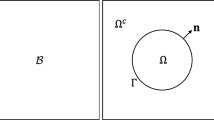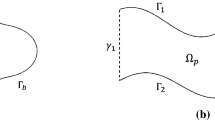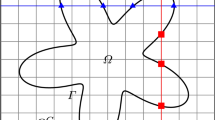Abstract
We present a kernel-free boundary integral method (KFBIM) for solving variable coefficients partial differential equations (PDEs) in a doubly connected domain. We focus our study on boundary value problems (BVP) and interface problems. A unique feature of the KFBIM is that the method does not require an analytical form of the Green’s function for designing quadratures but rather computes boundary or volume integrals by solving an equivalent interface problem on Cartesian mesh. We first decompose the problem defined in a doubly connected into two separate interface problems. The system of boundary integral equations is solved using the Krylov method. The method is second-order accurate in space, and its complexity is linearly proportional to the number of mesh points. Numerical examples demonstrate that the method is robust for variable coefficients PDEs, even for cases with large diffusion coefficients ratio and complex geometries where two interfaces are close.









Similar content being viewed by others
References
Pozrikidis C (1992) Boundary integral and singularity methods for linearized viscous flow. Cambridge texts in applied mathematics. Cambridge University Press, Cambridge
Sethian J (1996) Level set methods. Cambridge University Press, Cambridge
Hirt CW, Nichols BD (1981) Volume of fluid (vof) method for the dynamics of free boundaries. J Comput Phys 39(1):201–225
LeVeque RJ, Li ZL (1995) The immersed interface method for elliptic equations with discontinuous coefficients and singular sources. SIAM J Numer Anal 32:1019–1044
Peskin CS (2002) The immersed boundary method. Acta Numer 11:479
Ambrose DM, Siegel M, Zhang K (2021) Convergence of the boundary integral method for interfacial stokes flow. arXiv:2105.07056
Hou TY, Lowengrub J, Krasny R (1991) Convergence of a point vortex method for vortex sheets. SIAM J Numer Anal 28(2):308–320
Hao W, Bei H, Li S, Song L (2018) Convergence of boundary integral method for a free boundary system. J Comput Appl Math 334:128–157
Greengard L, Rokhlin V (1987) A fast algorithm for particle simulations. J Comput Phys 73:325–348
Cheng H, Greengard L, Rokhlin V (1999) A fast adaptive multipole algorithm in three dimensions. J Comput Phys 155:468–498
Liang Z, Gimbutas Z, Greengard L, Huang J, Jiang S (2013) A fast multipole method for the Rotne–Prager–Yamakawa tensor and its applications. J Comput Phys 234:133–139
Barnes J, Hut P (1986) A hierarchical o(nlogn) force-calculation algorithm. Nature 324:446–449
Lindsay K, Krasny R (2001) A particle method and adaptive treecode for vortex sheet motion in three-dimensional flow. J Comput Phys 172:879–907
Feng H, Barua A, Li S, Li X (2014) A parallel adaptive treecode algorithm for evolution of elastically stressed solids. Commun Comput Phys 15:365–387
Ying WJ, Henriquez CS (2007) A kernel-free boundary integral method for elliptic boundary value problems. J Comput Phys 227:1046–1074
Ying WJ, Wang WC (2013) A kernel-free boundary integral method for implicitly defined surfaces. J Comput Phys 252:606–624
Mayo A (1984) The fast solution of Poisson’s and the biharmonic equations on irregular regions. SIAM J Numer Anal 21:285–299
Mayo A (1985) Fast high order accurate solution of Laplace’s equation on irregular regions. SIAM J Sci Statist Comput 6:144–157
Ying WJ, Wang WC (2014) A kernel-free boundary integral method for variable coefficients elliptic PDES. Commun Comput Phys 15:1108–1140
Ying W (2018) A cartesian grid-based boundary integral method for an elliptic interface problem on closely packed cells. Commun Comput Phys 24:1196
Xie Y, Ying W (2019) A fourth-order kernel-free boundary integral method for the modified Helmholtz equation. J Sci Comput 78(3):1632–1658
Xie Y, Ying W, Wang W-C (2019) A high-order kernel-free boundary integral method for the biharmonic equation on irregular domains. J Sci Comput 80:1681
Xie Y, Ying W (2020) A high-order kernel-free boundary integral method for incompressible flow equations in two space dimensions. Numer Math Theory Methods Appl 13(3):595–619
Yaning X, Wenjun Y (2020) A fourth-order kernel-free boundary integral method for implicitly defined surfaces in three space dimensions. J Comput Phys 415:109
Shortley GH, Weller R (1938) Numerical solution of Laplace’s equation. J Appl Phys 9:334–348
Cheng LT, Gibou F, Fedkiw F, Kang M (2002) A second-order-accurate symmetric discretization of the Poisson equation on irregular domains. J Comput Phys 176:205–227
Beeson-Jones TH, Woods AW (2015) On the selection of viscosity to suppress the Saffman–Taylor instability in a radially spreading annulus. J Fluid Mech 782:127–143
Anjos Pedro HA, Shuwang L (2020) Weakly nonlinear analysis of the Saffman–Taylor problem in a radially spreading fluid annulus. Phys Rev Fluids 5:054002
Zhao M, Anjos Pedro HA, Lowengrub J, Shuwang L (2020) Pattern formation of the three-layer Saffman–Taylor problem in a radial Hele–Shaw cell. Phys Rev Fluids 5:124005
Gin C, Daripa P (2015) Stability results for multi-layer radial Hele–Shaw and porous media flows. Phys Fluids 27:012101
Salameh M, Singh S, Li S, Krishnamurthy M (2020) Surrogate vibration modeling approach for design optimization of electric machines. IEEE Trans Transp Electr 6:1126–1133
Lu M-J, Lowengrub J, Hao W, Li S (2021) Nonlinear simulation of vascular tumor growth with a necrotic core and chemotaxis
Min-Jhe L, Liu C, Lowengrub J, Li S (2020) Complex far-field geometries determine the stability of solid tumor growth with chemotaxis. Bull Math Biol 82:1–41
Saad Y, Schultz MH (1986) A generalized minimal residual method for solving non-symmetric linear systems. SIAM J Sci Statist Comput 7:856–869
Saad Y (1996) Iterative methods for sparse linear systems. PWS Publishing Company, Boston
Greenbaum A, Greengard L, McFadden GB (1993) Laplace’s equation and the Dirichlet–Neumann map in multiply-connected domains. J Comput Phys 105:267–278
Beale JT, Layton AT (2006) On the accuracy of finite difference methods for elliptic problems with interfaces. Commun Appl Math Comput Sci 1:91–119
Acknowledgements
S. L. and M. K acknowledge the support from the National Science Foundation, Division of Electrical, Communications and Cyber Systems grant ECCS-1927432. S. L. also acknowledges the partial support from the National Science Foundation, Division of Mathematical Sciences grant DMS-1720420. This work is also supported by the National Natural Science Foundation of China (Grant No. DMS-12101553, Grant No. DMS-11771290).
Author information
Authors and Affiliations
Corresponding author
Additional information
Publisher's Note
Springer Nature remains neutral with regard to jurisdictional claims in published maps and institutional affiliations.
Rights and permissions
Springer Nature or its licensor holds exclusive rights to this article under a publishing agreement with the author(s) or other rightsholder(s); author self-archiving of the accepted manuscript version of this article is solely governed by the terms of such publishing agreement and applicable law.
About this article
Cite this article
Cao, Y., Xie, Y., Krishnamurthy, M. et al. A kernel-free boundary integral method for elliptic PDEs on a doubly connected domain. J Eng Math 136, 2 (2022). https://doi.org/10.1007/s10665-022-10233-8
Received:
Accepted:
Published:
DOI: https://doi.org/10.1007/s10665-022-10233-8




